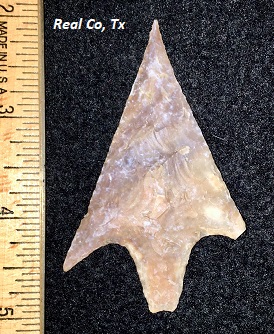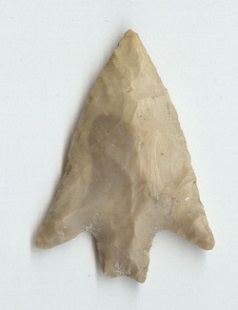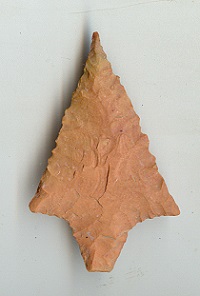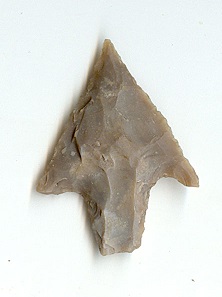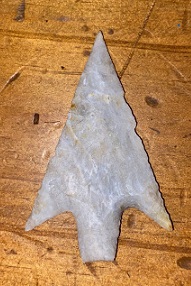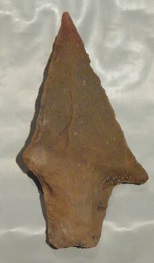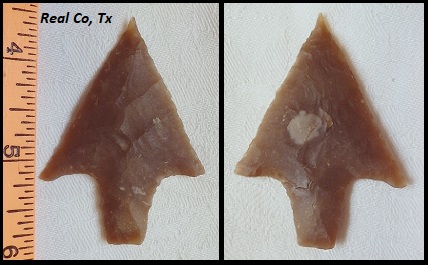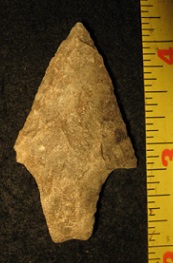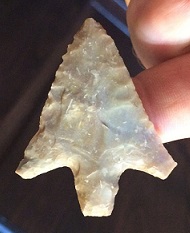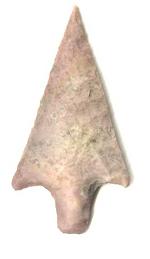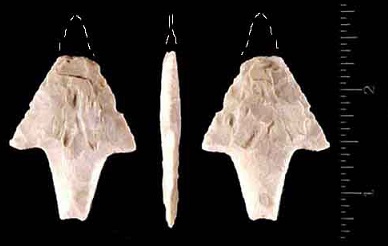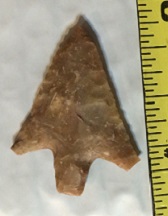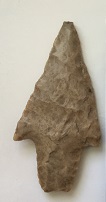Outline is Representative of Size and Shape:
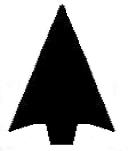
Name Details:
Identified By: J. Charles Kelly, Thomas N. Campbell, and Donald J. Lehmer
Named For: Langtry, Val Verde County, Texas
Date Identified: 1940
Type Site: Big Bend Region, Texas
Identified By: J. Charles Kelly, Thomas N. Campbell, and Donald J. Lehmer
Named For: Langtry, Val Verde County, Texas
Date Identified: 1940
Type Site: Big Bend Region, Texas
Point Validity:
Valid type
Kelley was a distinguished anthropologist who served as Curator of the Archaeological Museum at the University of Texas-Austin and was instrumental in setting up the Department of Anthropology at the University of Texas-Austin. He specialized in the archaeology of western Texas. Campbell is a distinguished anthropologist and was a professor for the Department of Anthropology, University of Texas. He conducted extensive studies into the archaeology of Texas and was an expert on the archaeology of the Gulf Coastal region of Texas. Lehmer was an anthropologist who was an expert on the archaeology of the Plains region. This point was named in a professional publication and has many professional references. This is considered a valid type.
Kelley was a distinguished anthropologist who served as Curator of the Archaeological Museum at the University of Texas-Austin and was instrumental in setting up the Department of Anthropology at the University of Texas-Austin. He specialized in the archaeology of western Texas. Campbell is a distinguished anthropologist and was a professor for the Department of Anthropology, University of Texas. He conducted extensive studies into the archaeology of Texas and was an expert on the archaeology of the Gulf Coastal region of Texas. Lehmer was an anthropologist who was an expert on the archaeology of the Plains region. This point was named in a professional publication and has many professional references. This is considered a valid type.
Langtry Barbed
Cluster: Description of Physical Characteristics and Flaking Pattern:
This is a thin medium triangular contracting stem point with a flattened to elliptical cross section. The blade is primarily straight, but may range from slightly incurvate or recurvate, rarely excurvate. The shoulders are prominent and usually at a downward slope or angle, but may vary to horizontal. The shoulders are often uneven or asymmetrical. The stem is contracting or tapering and commonly has alternating beveling on the stem and beveling on the base. The base may range from straight to slightly concave (convex bases are consistent with Langtry Arenosa points). This point is usually well made point with a random flaking pattern.
This is a thin medium triangular contracting stem point with a flattened to elliptical cross section. The blade is primarily straight, but may range from slightly incurvate or recurvate, rarely excurvate. The shoulders are prominent and usually at a downward slope or angle, but may vary to horizontal. The shoulders are often uneven or asymmetrical. The stem is contracting or tapering and commonly has alternating beveling on the stem and beveling on the base. The base may range from straight to slightly concave (convex bases are consistent with Langtry Arenosa points). This point is usually well made point with a random flaking pattern.
Size Measurements:
Length - 40 to 70 mm (average 60 mm), Stem Length - 10 to 15 mm (typically 1/4 to 1/2 the total length), Width at shoulders - 22 to 40 mm, Stem Width - 6 to 16 mm
Length - 40 to 70 mm (average 60 mm), Stem Length - 10 to 15 mm (typically 1/4 to 1/2 the total length), Width at shoulders - 22 to 40 mm, Stem Width - 6 to 16 mm
Commonly Utilized Material:
Additional Comments:
Suhm and Krieger (1954) included both the classic Langtry and the newer identified Langtry Arenosa into the Langtry type. They noted that the two may represent separate type, but the two represent a continuum and is difficult to draw a clear line between the two types.
Bell and Hall (1947) reported this type into Oklahoma and into Missouri. Since that time there have been many professional publications that have included this type into that region. However, the overall characteristics of Langtry points from Oklahoma and Missouri are different from the types found in southern Texas. Suhm and Krieger (1954) examined the points from Bell and Hall and concluded that these points were incorrectly identified as Langtry points. They noted that they are narrower, thicker, and lack the techniques used to make the Langtry type. They concluded that the points found by Bell and Hall were "incorrectly identified" and were not Langtry points. Turner and Hester (2014) echo this sentiment stating that true Langtry points are found in southern Texas and do not extend into Oklahoma and Missouri.
Suhm and Krieger (1954) included both the classic Langtry and the newer identified Langtry Arenosa into the Langtry type. They noted that the two may represent separate type, but the two represent a continuum and is difficult to draw a clear line between the two types.
Bell and Hall (1947) reported this type into Oklahoma and into Missouri. Since that time there have been many professional publications that have included this type into that region. However, the overall characteristics of Langtry points from Oklahoma and Missouri are different from the types found in southern Texas. Suhm and Krieger (1954) examined the points from Bell and Hall and concluded that these points were incorrectly identified as Langtry points. They noted that they are narrower, thicker, and lack the techniques used to make the Langtry type. They concluded that the points found by Bell and Hall were "incorrectly identified" and were not Langtry points. Turner and Hester (2014) echo this sentiment stating that true Langtry points are found in southern Texas and do not extend into Oklahoma and Missouri.
Distribution: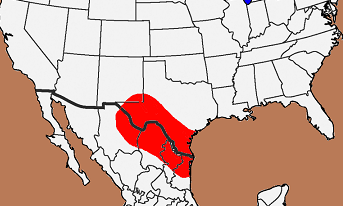

Distribution Comments:
This point is primarily found in the lower Pecos River into the Trans-Pecos region into southeastern New Mexico and northern Coahuila and Tamaulipas. Extends into the Nueces River Valley of Texas and central Tamaulipas. Frequency decreases towards the coastal regions. Please see additional comments regarding distribution into
This point is primarily found in the lower Pecos River into the Trans-Pecos region into southeastern New Mexico and northern Coahuila and Tamaulipas. Extends into the Nueces River Valley of Texas and central Tamaulipas. Frequency decreases towards the coastal regions. Please see additional comments regarding distribution into
Age / Periods:
Date: 4,500 - 3,000 B.P.
Cultural Period: Middle Archaic
Glacial Period: Neoglacial
Culture:
Date: 4,500 - 3,000 B.P.
Cultural Period: Middle Archaic
Glacial Period: Neoglacial
Culture:
Age Details:
Similar Points:
Almagre, Arledge, Axolotl, Coahuila, Encino Type II, Gary, Hidden Valley, Perdiz, San Isidro, Searcy, Shincola, Standlee, Tecolate Type II, Val Verde
Almagre, Arledge, Axolotl, Coahuila, Encino Type II, Gary, Hidden Valley, Perdiz, San Isidro, Searcy, Shincola, Standlee, Tecolate Type II, Val Verde

